If you’re looking to get a new cutting board, you’re probably wondering if you should get a plastic one or a wooden one. So what’s the real difference of wood vs plastic cutting boards?
Plastic cutting boards can be sent through the diswasher, are cheap, and lightweight but they aren’t as durable and can get knife cut grooves that harbor bacteria. Wooden cutting boards look better aesthetically, are durable, and have antibacterial properties, but they are more expensive and require more upkeep than plastic ones.
This is just a brief overview, there’s a ton of other details in this post. We’ll break down the pros and cons of each, do a side by side comparison, and then tell you how to properly care for both wood and plastic boards.
Let’s get to it!
Table of Contents
Wood Cutting Boards
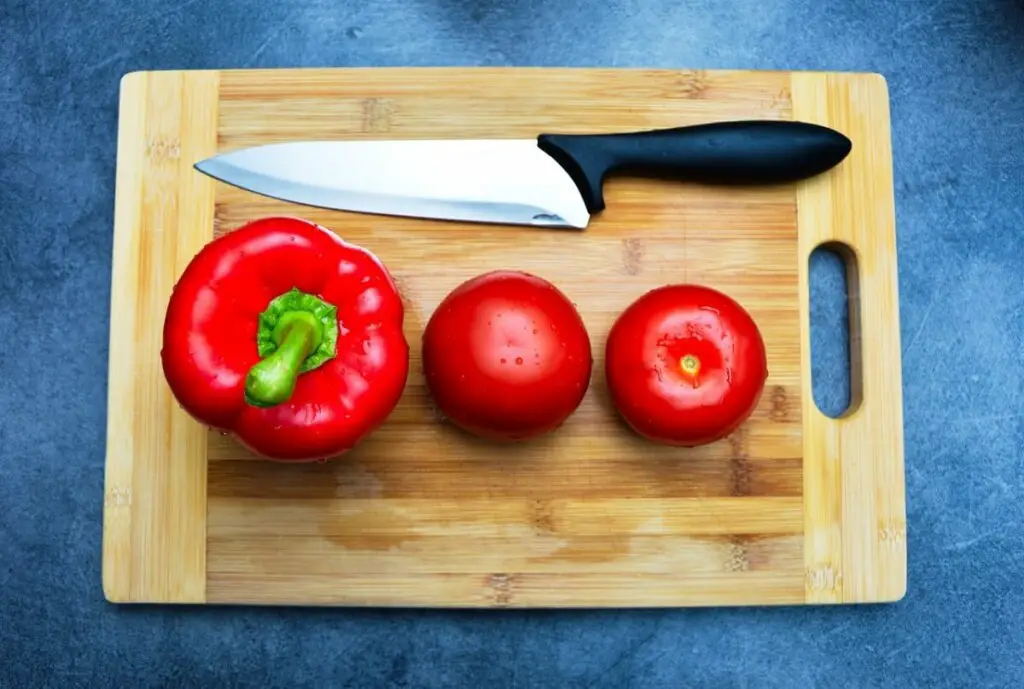
Before we do a side-by-side comparison, we’re going to break down the pros and cons of both wood cutting boards and plastic cutting boards.
Wooden cutting boards come in all shapes and sizes, they offer many great benefits but also have a few drawbacks.
Let’s jump into the pros and cons of wooden cutting boards.
Pros
1. Durable
First and foremost, wooden cutting boards are super durable. It’s just a slab of wood, doesn’t get much more durable than that.
This is great if you want your cutting board to last you a long time. With proper upkeep, wooden cutting boards could last a lifetime.
2. Aesthetics
This depends a little bit on the style of your kitchen. In general, wood cutting boards will be more aesthetically pleasing than the plastic alternative which can look cheap.
There are also a ton of different styles of wood boards. You can get different colors depending on what type of wood it’s made out of.
They can also be many different shapes from small to a large butcher block to fun shapes. When my dad was younger he made a pig-shaped cutting board in shop class and I am still using it today!
3. Gentle on Knives
There is nothing more satisfying to me than a great kitchen knife. If you’ve got a great kitchen knife, which was probably expensive, then you want to take good care of it.
Wooden cutting boards are gentle on knives, meaning they will dull the edge much slower than other kinds of cutting boards.
If you have a kitchen knife collection or just don’t want to have to think about sharpening your knives, a wooden board will help keep the sharp edge on your knives.
Cons
Now that we’ve talked about some of the great things about wooden boards, let’s talk about some of the not quite so good things.
1. Cost
In general, a wooden chopping board will be more expensive than the plastic alternative.
There are some types of wood, such as a bamboo board, that will give you the benefits of wood without being as expensive as hardwood like maple or black walnut.
Do some research to find out what is the best cutting board for you and your budget.
2. Harder to Clean
This is probably one of the main reasons people prefer plastic cutting boards over wooden boards.
Wooden cutting boards are harder to clean. You can’t put them in the dishwasher, they have to be hand-washed. This is a deal breaker for some people.
But, because they’re durable, there will not be as many deep knife cuts in the board as in a plastic one which makes it easier to scrub.
3. Require Some Upkeep
This one can be a con and a pro. Wood cutting boards do require some upkeep, however, if you do the upkeep, the cutting board will last for much, much longer than plastic counterparts.
After some use, the finish on the wood cutting board will wear off exposing the soft grain underneath. When this happens, you should give your wooden cutting board a little spa day and treat it with some food-safe mineral oil.
I’ll show you how to do this in one of the sections below. The mineral oil will make the wood cutting board look brand new which is something you can’t do with a plastic board.
Plastic Cutting Boards
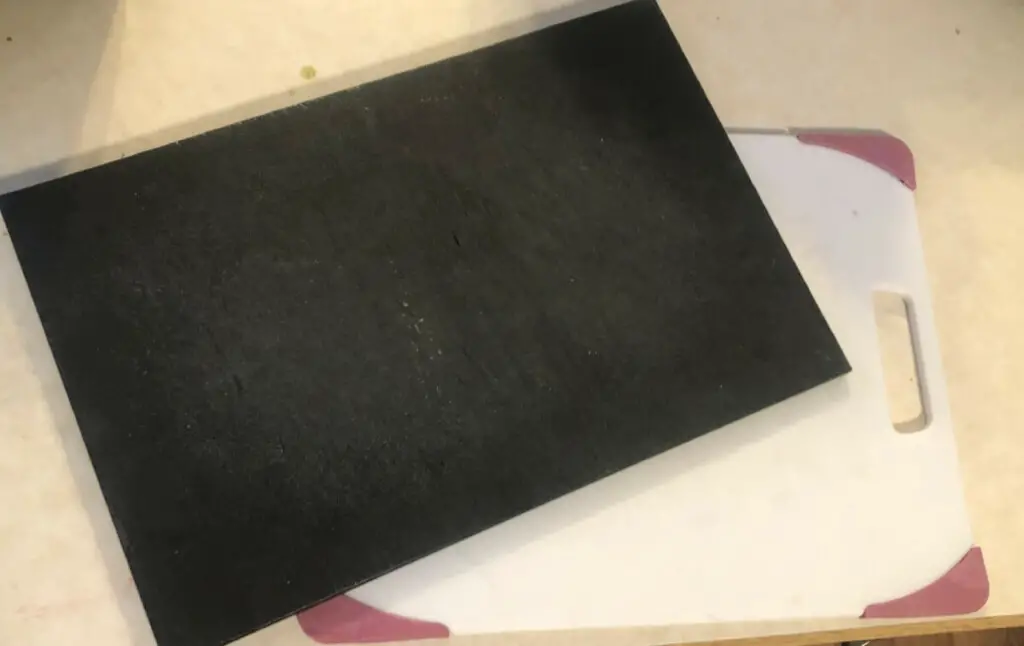
Now that we’ve talked about the good stuff with wood cutting boards, let’s switch to plastic cutting boards.
Pros
1. Easy to Clean
This is probably the biggest reason why people want plastic chopping boards, you can put them straight in the dishwasher, easy peasy.
But, if you don’t have a dishwasher, it can be difficult to get in all the nooks and crannies of knife marks in a plastic cutting board.
2. Inexpensive
Plastic boards are inexpensive compared to some wooden cutting boards. But, there are more expensive plastic boards and there are cheaper wooden cutting boards.
When looking into the price, it depends on what works best for you and your budget. There’s no wrong answer in terms of what cutting board you should get, it all depends on what you want and can afford.
3. Lightweight
Plastic boards are also nice and lightweight, which is great, not everyone wants to haul around a giant butcher block all the time.
You might be worried about the board sliding around, but a lot of plastic cutting boards come with rubber edges or sticky stuff on the edges so they won’t slide around while you’re working.
Cons
Now let’s get into the not-so-great things about plastic cutting boards.
1. Aesthetics
First, plastic cutting boards aren’t great in terms of aesthetics, they just don’t look as nice as wooden alternatives.
However, it depends on what kind of look or feel you’re going for, there are probably plastic cutting boards out there that will fit the aesthetic you’re looking for.
2. Durability
Plastic cutting boards aren’t durable. They can easily get knife cuts in them and if they’re washed in the dishwasher frequently, the rubber around the edges can begin to peel off.
So, although it’s easier to just throw them in the dishwasher, it would be a good idea to hand wash them sometimes to give them a break from the dishwasher.
3. Overall Cleanliness
Once plastic cutting boards develop cut marks or deep grooves from knives, bacteria can gather in these areas because it’s difficult to clean. If your board develops a lot of these cuts, then it might be time to retire it.
If you’re worried about bacteria building up in these areas, you can also hand wash it with a stiff bristle brush and scrub along the length of the cuts. That will help get into all those pesky crevices.
Wood Vs. Plastic Cutting Boards
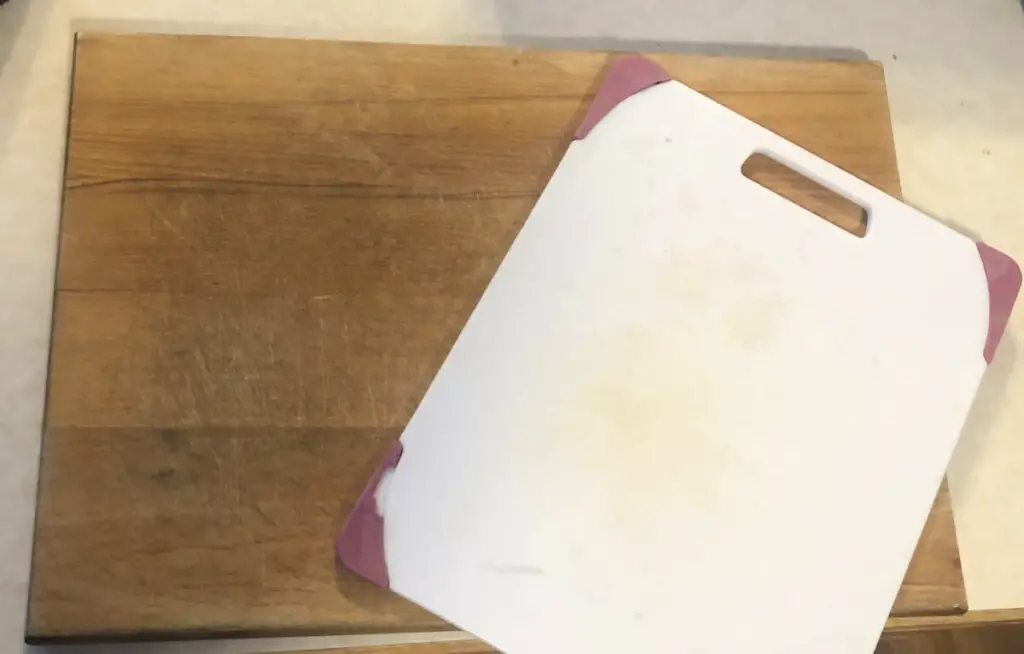
Now that you’ve got a good understanding of wooden and plastic cutting boards, let’s compare them to one another and see how they stack up.
After this, you should be able to choose the right cutting board for you.
1. Care
Plastic cutting boards are easier to care for than wooden cutting boards. Plastic boards can be put in the dishwasher and don’t require any special upkeep.
Wooden cutting boards should be hand-washed and need to be refinished once the finish on the boards wears off and they begin to get dull.
See cutting board care below for more information about caring for each board.
2. Look/Aesthetic
This one is pretty subjective, but, in general, wooden cutting boards look better and have a better aesthetic than plastic boards.
But, then depends a lot on the style of your kitchen and your personal preference. There is a wide variety of styles when it comes to wooden cutting boards and there are just as many for plastic boards.
It’s up to you to decide which aesthetic fits you best.
3. Cost
Plastic cutting boards are cheaper than wooden cutting boards.
There are some cheaper options when it comes to wood cutting boards such as a bamboo cutting board. And wooden cutting boards will last longer than plastic ones.
If you’re looking for a cheap, quick option for a cutting board, then grab a plastic one.
4. Durability
When it comes to durability, wooden cutting boards are more durable than plastic cutting boards.
I’m still using a wooden cutting board that my dad made when he was in high school. It’s shaped like a pig, it’s great.
However, for wooden boards to last as long as they do, they require some upkeep. Once your cutting board loses its finish and becomes dull, you should treat it with food-safe mineral oil.
This will condition the wood grains and give your cutting board the nice sheen that it had when it was brand new. For a full tutorial on taking care of your boards, check out the section below.
5. Food Safety
A common misconception that people have is that wooden surfaces grow bacteria more than plastic cutting boards. The opposite is true.
Wood has antibacterial properties which means that when the bacteria gets absorbed into the wood grains, the bacteria won’t grow, it will be destroyed.
Also, once plastic cutting boards develop grooves and knife cuts from a lot of use, these grooves become a haven for bacteria. If this happens then it’s time to retire your cutting board.
But, plastic cutting boards are easier to clean because they can be put directly in the dishwasher. Dishwashers use extremely hot water which is a great way to disinfect your cutting boards.
The biggest concern with food safety is cross-contamination. You should never cut anything on the same surface you used to cut raw meat without cleaning it first.
The best practice is to use one cutting board for raw meat and a completely different board for everything else. This will eliminate all possibility of cross contamination.
In conclusion, both cutting boards can be used safely when cutting meat and vegetables as long as you practice food safety.
For information regarding all things food safety, check out the US Department of Agriculture’s website. They cover everything from how to prevent cross contamination to what temperature to cook your meat.
If you love cooking in a crock pot but are worried about food safety when using meat, check out our other post about slow cooker temperatures.
Cutting Board Care
It’s important to take proper care of your cutting board, so here I outline best practices to follow to make sure your cutting boards last as long as they can.
Plastic Cutting Board
Plastic cutting boards don’t require much special care, regularly wash them either in a dishwasher or by hand with warm water and soap and you should be good to go.
However, some foods can leave discolorations or stains on plastic cutting boards. If this is the case, you can clean it in a specific way to get rid of those pesky stains.
This method comes from Cutco’s website. You’ll need the following materials:
- Baking soda
- Dish soap
- Hydrogen peroxide
Once you have them, mix four parts baking soda, one part dish soap, and two parts hydrogen peroxide. Mix it up to create a paste and apply that to the stained area of your cutting board.
Cutco recommends letting it sit for at least six hours or overnight if possible. Then, rinse and wipe it off and the stains in your cutting board should be gone or at least much less notable.
You should not use bleach on your plastic cutting boards because of how corrosive bleach can be, it could do more harm than good. Stick with this gentler method to help your cutting boards look like new.
Wood Cutting Board
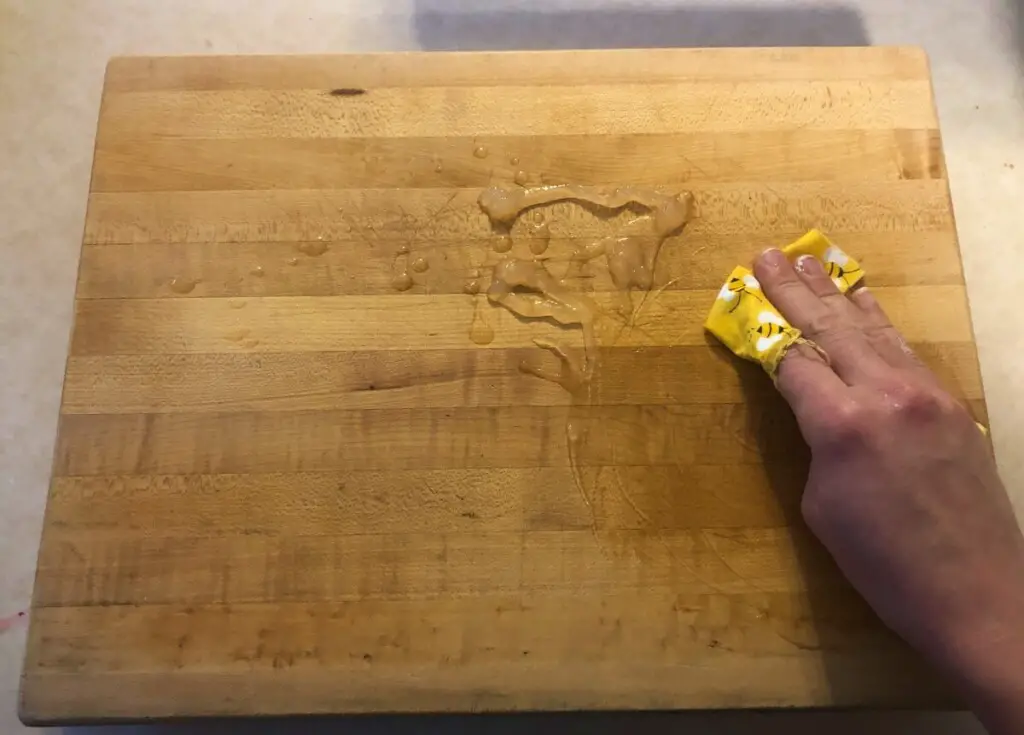
Wood cutting boards require more upkeep than plastic ones, but the upkeep is fairly simple.
Once your wooden board starts to loose it’s glossy sheen, if you notice that the wood grains are sticking out, or if the grains are more noticable, it’s time to treat your refinish your wooden cutting board.
Refinishing a Wood Cutting Board
In the picture above, you can already see the difference between the side that has oil on it (right) and the side that doesn’t (left). This process is super easy.
To refinish your wood cutting board, you’ll need the following materials:
- Food-grade mineral oil (Butcher block conditioner)
- Rag (old t-shirt or dishtowel scrap)
For your oil, you should look for butcher block conditioner which is usually food grade mineral oil mixed with beeswax and some other oils. Here’s the bottle that I have:
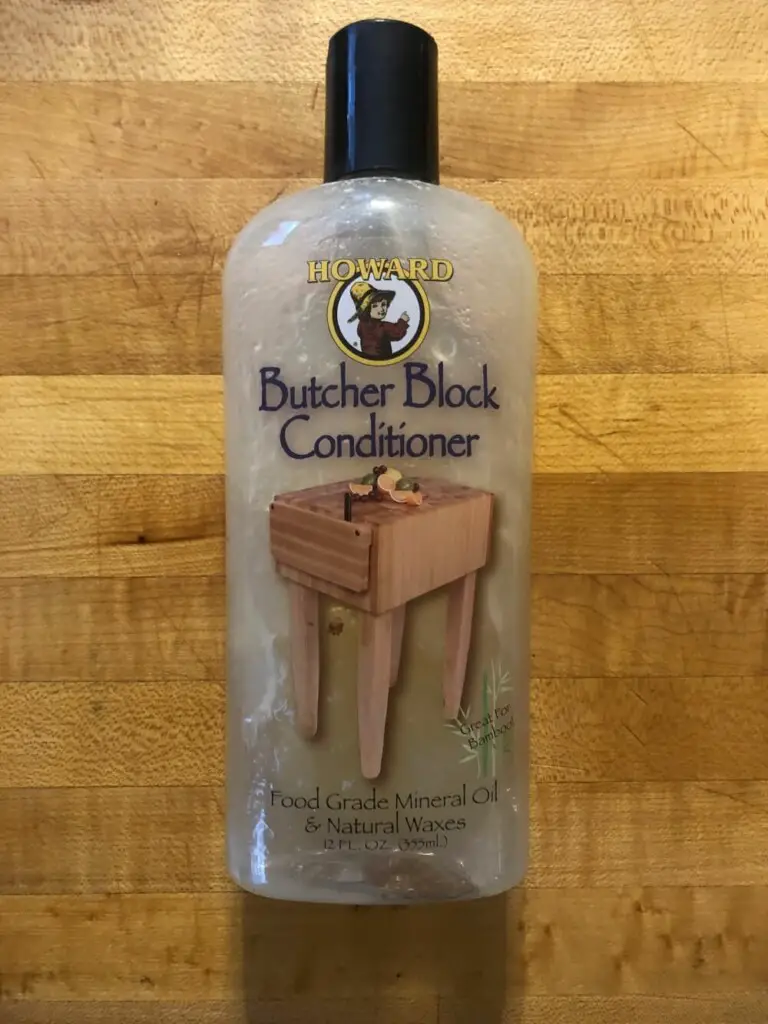
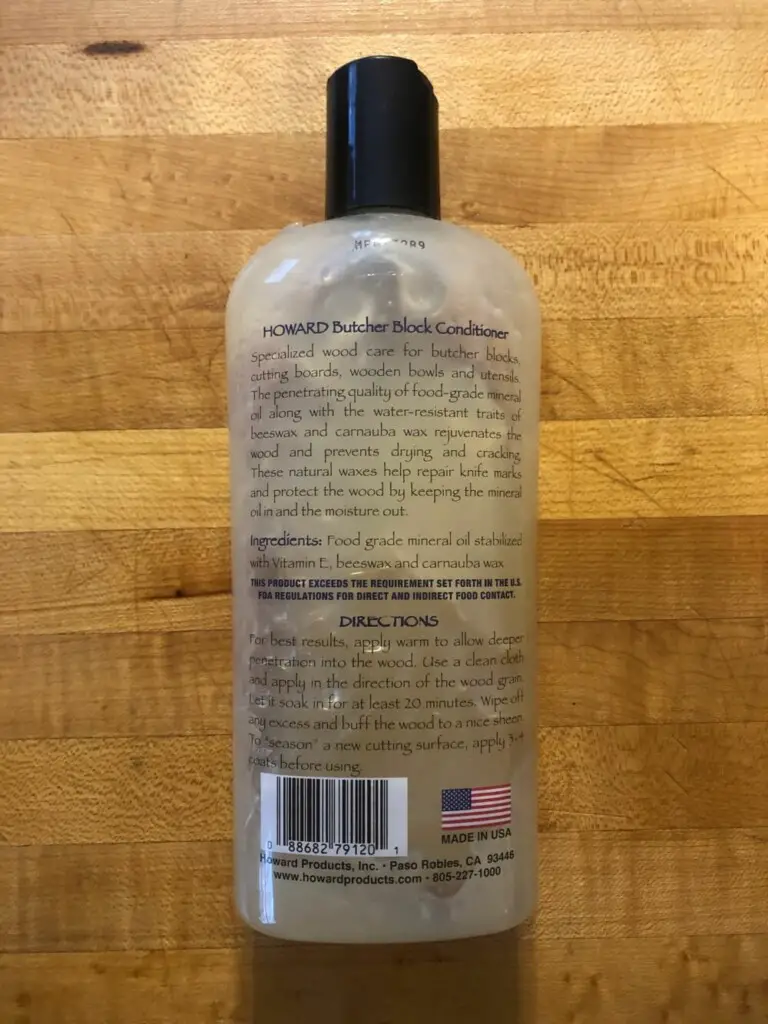
Once you have your conditioner, follow the instructions on the bottle to treat your cutting board. The instructions will be something like this:
- Wipe the surface down in the direction of the wood grain
- Let it sit for at least twenty minutes
- Wipe off the excess oil after at least twenty minutes
- For a better sheen, ‘buff’ the surface by continuing to wipe it
- If it’s a new cutting board that needs ‘seasoned’, repeat the process 3-4 times
All of that is directly off the back of my bottle of butcher block conditioner.
If you follow these instructions, you’ll keep your wooden cutting boards looking like they’re brand new.
Related Questions
Is Plastic More Hygienic than Wood?
No, wood is more hygienic than plastic because the wood itself has antibacterial properties. Plastic can be hygienic until it develops deep knife cuts that will gather bacteria and increase bacterial growth. To prevent bacteria growth, clean your plastic or wood cutting board thoroughly after every use.
What Cutting Boards Do Chefs Use?
Most commercial kitchens will use plastic cutting boards because they can be sent through the industrial dishwasher. They are also lighter and allow things to be carried easily from one side of the kitchen to the other.
